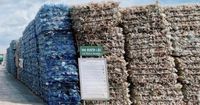In recent years, the intersection of industrial ambition and environmental stewardship in Vietnam has come to a head, with two of the country’s most pressing challenges—waste management and the transformation of the plastics industry—demanding urgent and innovative solutions. Nowhere is this more apparent than in Ninh Bình province, where the mounting crisis at the Thung Quèn Khó landfill and the broader shift in the plastics sector both reflect the nation’s struggle—and determination—to balance economic growth with sustainability.
Just a stone’s throw from the famed Tràng An Heritage Site, the Thung Quèn Khó landfill stands as a stark symbol of the environmental pressures facing Ninh Bình. According to Nhân Dân, after more than two decades of service, the landfill has transformed into a massive “artificial mountain,” now one of the most severely polluted locations in the province. The numbers are staggering: the site receives an average of 430 tons of household waste daily, more than double its designed processing capacity of 200 tons per day and night. With this overflow, temporary burial has become the norm, pushing storage pits A and B to the brink of collapse.
The consequences are visible and visceral. Mounds of garbage tower precariously, leachate—thick, black, and foul-smelling—spills onto internal roads, and the stench permeates nearby residential areas. "On sunny days, the odor is overwhelming; when it rains, wastewater floods the streets, and flies swarm everywhere," shared Nguyễn Thị Hoa, a resident of Trung Sơn ward, with Nhân Dân. Her sentiments echo the frustrations of many locals who have grown weary of living alongside uncollected waste and makeshift dumps.
The Ninh Bình Solid Waste Treatment Plant, responsible for managing the landfill, is buckling under pressure. As director Lã Phú Dũng explained to Nhân Dân, the plant’s machinery is aging and requires frequent maintenance, driving up already high operational costs. Despite operating on a self-financing basis, the plant struggles to fund even two production shifts. The treatment fee—set at just 90,200 VND per ton—is far below the actual cost, leading to a budget shortfall of over 2.2 billion VND each year.
Complicating matters further, waste sorting at the source is virtually nonexistent, contaminating the organic fertilizer production line and reducing both product quality and inventory turnover. The plant’s current approach remains largely dependent on landfilling, a model that stands in stark contrast to the province’s stated vision of “green and circular” development.
The scale of the problem isn’t isolated to Thung Quèn Khó. In the Hà Nam area, nearly 94,000 tons of waste were generated by September 2025, with over 12,000 tons still languishing in 29 communes and wards. Temporary collection points have devolved into open-air dumps, where flies breed and black wastewater seeps into rice fields. The root causes? Rapid growth in waste generation, unsynchronized collection and treatment, and outdated sanitation service pricing that fails to cover real costs.
Local authorities are feeling the heat. Trung Sơn ward’s chairman, Tống Đức Thuận, told Nhân Dân, "The overload at Quèn Khó has persisted for years. Our ward has repeatedly petitioned higher authorities for decisive action. The scale of the landfill exceeds local capacity, and direct provincial management with reasonable financial mechanisms is urgently needed."
Recognizing the gravity of the situation, the provincial People’s Committee has ordered a coordinated response. All localities must unify transportation schedules, accurately determine waste volumes for payment, and ramp up public education campaigns to encourage source sorting. The mandate is clear: by October 15, 2025, all accumulated waste must be processed, or responsible units will be held accountable.
But while these are necessary stopgap measures, Ninh Bình is also looking to the future. Since 2023, the provincial government has issued comprehensive guidance on finance, service pricing, treatment planning, and investment in a new waste-to-energy plant at Quèn Khó, designed to process 500 tons of waste per day and night. As chairman Phạm Quang Ngọc stated, "While waiting for the new waste-to-energy plant to begin construction, the province requires increased use of deodorizing agents, lining, and on-site temporary treatment to minimize impacts on residents."
Alongside infrastructure upgrades, the province is rolling out a new pricing mechanism and launching the "Source sorting of waste in the 2025-2030 period" project. The goal? To create a circular solid waste economy where trash is seen as a resource, not just a burden. A pay-as-you-throw model is also on the horizon, incentivizing households to reduce and sort their waste, thus fostering a culture of environmental responsibility.
This local struggle mirrors a broader transformation underway in Vietnam’s plastics industry—a sector once notorious for pollution, now at the forefront of the green transition. As reported by VietQ.vn, the industry is embracing a sweeping green strategy that covers everything from raw materials to production and export standards. With over 4,000 companies contributing nearly $10 billion in annual exports, the sector’s dependence on imported raw materials—currently 70-80%—has long been a vulnerability. The industry’s ambitious goal by 2030 is to domestically source at least 70% of its materials, with 30% coming from high-quality recycled plastics.
This shift is not just about supply chains; it’s about meeting the stringent environmental standards of major markets like the EU, US, and Japan. New national standards such as TCVN 13165:2020—covering the technical and safety requirements for recycled plastics—are paving the way for Vietnam’s plastics to compete globally. Companies are investing in bio-based materials, biodegradable packaging, and eco-friendly products that comply with ISO 14001:2015 and ISO 50001, the international benchmarks for environmental and energy management.
Some firms are already leading the charge. Duy Tân, for example, operates a recycling plant that processes more than 200 tons of plastic waste daily, achieving a “three zeroes” model: no waste, no wastewater, and no air emissions. This closed-loop approach is becoming the industry standard, especially as regulations like EPR (Extended Producer Responsibility) under Decree 08/2022/NĐ-CP require companies to collect and recycle packaging after consumer use.
The stakes are high. The EU now mandates that plastic packaging must contain at least 30% recycled content by 2030 and comply with REACH and RoHS regulations limiting hazardous chemicals. Vietnam is aligning its own standards, introducing measures like the Circular Plastics Index to track recycling rates, CO₂ emissions, and energy management.
Environmental experts warn that meeting these green standards is more than a market advantage—it’s a passport to the future. As global trade barriers increasingly hinge on emissions, traceability, and sustainability, failure to adapt could sideline Vietnamese plastics from lucrative international markets. The industry stands at a crossroads: stick with old, linear models and risk environmental backlash, or fully commit to green, circular, and standardized production. The path ahead is challenging, requiring significant capital, advanced technology, and robust legal frameworks. But as VietQ.vn notes, success could see Vietnam’s plastics industry shed its polluter image and emerge as a key player in the nation’s drive for net-zero emissions by 2050.
From the overloaded landfills of Ninh Bình to the evolving factories of the plastics sector, Vietnam’s journey toward sustainable development is fraught with obstacles—but also rich with possibility. The message is clear: only by treating waste as a resource and embracing green innovation can the country safeguard its heritage, its economy, and its future.




